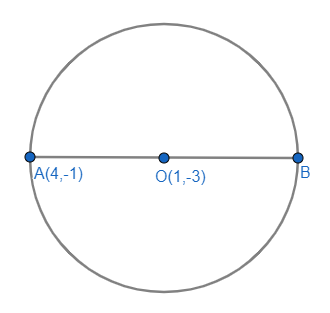
The co-ordinates of one end point of a diameter of a circle are (4, -1) and co-ordinates of the centre of circle are (1, -3). Then coordinates of the other end of the diameter are
(A) (2,5)
(B) (-2, -5)
(C) (3,2)
(D) (-3, -2)
Answer
573.6k+ views
Hint: We start solving this problem by assuming the given endpoint as A and centre as O and the other endpoint as B and radius as r. Then we find the ratio of OB and AB. Then we use the formula for the point dividing two points in the ratio m:n externally, that is $\left( \dfrac{m{{x}_{2}}-n{{x}_{1}}}{m-n},\dfrac{m{{y}_{2}}-n{{y}_{1}}}{m-n} \right)$ and find the coordinates of B.
Complete step-by-step answer:
We are given that one end point of a circle is (4, -1). We are also given that coordinates of the centre of the circle are (1, -3).
Let us assume that the radius of the circle as r and given endpoint as A and centre as O. Let the other endpoint that we need to find be B.

As OA and OB are the radius of the circle, we have OA=OB=r.
AB is the diameter of the circle. So, we have AB=2r.
Let us consider the ratio of OB and AB
$\dfrac{OB}{AB}=\dfrac{r}{2r}=\dfrac{1}{2}$
It means that B divides O and A in the ratio 1:2 externally.
Now let us consider the formula for the coordinates of the point dividing two points $\left( {{x}_{1}},{{y}_{1}} \right)$ and $\left( {{x}_{2}},{{y}_{2}} \right)$ in the m:n externally is
$\left( \dfrac{m{{x}_{2}}-n{{x}_{1}}}{m-n},\dfrac{m{{y}_{2}}-n{{y}_{1}}}{m-n} \right)$
Using this formula, we can find the coordinates of B as,
$\begin{align}
& \Rightarrow \left( \dfrac{1\left( 4 \right)-2\left( 1 \right)}{1-2},\dfrac{1\left( -1 \right)-2\left( -3 \right)}{1-2} \right) \\
& \Rightarrow \left( \dfrac{4-2}{-1},\dfrac{-1+6}{-1} \right) \\
& \Rightarrow \left( \dfrac{2}{-1},\dfrac{5}{-1} \right) \\
& \Rightarrow \left( -2,-5 \right) \\
\end{align}$
So, coordinates of the centre of the circle is (-2, -5).
So, the correct answer is “Option B”.
Note: We can also solve this question in another method. As we have above that OA=OB=r,
it means that O divides A and B in the equal ratio, that is O is the midpoint of A and B.
Now, let us consider the formula for the co-ordinates of the midpoint of two points $\left( {{x}_{1}},{{y}_{1}} \right)$ and $\left( {{x}_{2}},{{y}_{2}} \right)$ is
$\left( \dfrac{{{x}_{1}}+{{x}_{2}}}{2},\dfrac{{{y}_{1}}+{{y}_{2}}}{2} \right)$
Let us assume that the coordinates of B as (a, b). Then using the above formula, we have
$\begin{align}
& \Rightarrow \left( \dfrac{4+a}{2},\dfrac{-1+b}{2} \right)=\left( 1,-3 \right) \\
& \Rightarrow \left( 4+a,-1+b \right)=\left( 2,-6 \right) \\
& \Rightarrow \left( a,b \right)=\left( 2-4,-6+1 \right) \\
& \Rightarrow \left( a,b \right)=\left( -2,-5 \right) \\
\end{align}$
Hence, we get the coordinates of B as (-2, -5).
Hence the answer is Option B.
Complete step-by-step answer:
We are given that one end point of a circle is (4, -1). We are also given that coordinates of the centre of the circle are (1, -3).
Let us assume that the radius of the circle as r and given endpoint as A and centre as O. Let the other endpoint that we need to find be B.

As OA and OB are the radius of the circle, we have OA=OB=r.
AB is the diameter of the circle. So, we have AB=2r.
Let us consider the ratio of OB and AB
$\dfrac{OB}{AB}=\dfrac{r}{2r}=\dfrac{1}{2}$
It means that B divides O and A in the ratio 1:2 externally.
Now let us consider the formula for the coordinates of the point dividing two points $\left( {{x}_{1}},{{y}_{1}} \right)$ and $\left( {{x}_{2}},{{y}_{2}} \right)$ in the m:n externally is
$\left( \dfrac{m{{x}_{2}}-n{{x}_{1}}}{m-n},\dfrac{m{{y}_{2}}-n{{y}_{1}}}{m-n} \right)$
Using this formula, we can find the coordinates of B as,
$\begin{align}
& \Rightarrow \left( \dfrac{1\left( 4 \right)-2\left( 1 \right)}{1-2},\dfrac{1\left( -1 \right)-2\left( -3 \right)}{1-2} \right) \\
& \Rightarrow \left( \dfrac{4-2}{-1},\dfrac{-1+6}{-1} \right) \\
& \Rightarrow \left( \dfrac{2}{-1},\dfrac{5}{-1} \right) \\
& \Rightarrow \left( -2,-5 \right) \\
\end{align}$
So, coordinates of the centre of the circle is (-2, -5).
So, the correct answer is “Option B”.
Note: We can also solve this question in another method. As we have above that OA=OB=r,
it means that O divides A and B in the equal ratio, that is O is the midpoint of A and B.
Now, let us consider the formula for the co-ordinates of the midpoint of two points $\left( {{x}_{1}},{{y}_{1}} \right)$ and $\left( {{x}_{2}},{{y}_{2}} \right)$ is
$\left( \dfrac{{{x}_{1}}+{{x}_{2}}}{2},\dfrac{{{y}_{1}}+{{y}_{2}}}{2} \right)$
Let us assume that the coordinates of B as (a, b). Then using the above formula, we have
$\begin{align}
& \Rightarrow \left( \dfrac{4+a}{2},\dfrac{-1+b}{2} \right)=\left( 1,-3 \right) \\
& \Rightarrow \left( 4+a,-1+b \right)=\left( 2,-6 \right) \\
& \Rightarrow \left( a,b \right)=\left( 2-4,-6+1 \right) \\
& \Rightarrow \left( a,b \right)=\left( -2,-5 \right) \\
\end{align}$
Hence, we get the coordinates of B as (-2, -5).
Hence the answer is Option B.
Recently Updated Pages
Master Class 11 Business Studies: Engaging Questions & Answers for Success

Master Class 11 Computer Science: Engaging Questions & Answers for Success

Master Class 11 Maths: Engaging Questions & Answers for Success

Master Class 11 Chemistry: Engaging Questions & Answers for Success

Master Class 11 Economics: Engaging Questions & Answers for Success

Master Class 11 Accountancy: Engaging Questions & Answers for Success

Trending doubts
What is meant by exothermic and endothermic reactions class 11 chemistry CBSE

10 examples of friction in our daily life

One Metric ton is equal to kg A 10000 B 1000 C 100 class 11 physics CBSE

1 Quintal is equal to a 110 kg b 10 kg c 100kg d 1000 class 11 physics CBSE

Difference Between Prokaryotic Cells and Eukaryotic Cells

What are Quantum numbers Explain the quantum number class 11 chemistry CBSE




